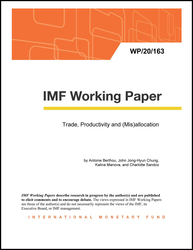
Trade, Productivity and (Mis)allocation
Trade, Productivity and (Mis)allocation
READ MORE...
Volume/Issue:
Volume 2020
Issue 163
Publication date: August 2020
ISBN: 9781513554440
$18.00
Add to Cart by clicking price of the language and format you'd like to purchase
Available Languages and Formats
| English |
Prices in red indicate formats that are not yet available but are forthcoming.
Topics covered in this book
This title contains information about the following subjects.
Click on a subject if you would like to see other titles with the same subjects.
Exports and Imports , Finance , WP , math display , total factor productivity , International trade , export demand , import competition , productivity , allocative efficiency , misallocation , aggregate productivity , resource misallocation , employment share , real value , productivity gain , firm productivity , Exports , Imports , Trade liberalization , Competition , Global
Also of interest
Summary
We examine the gains from globalization in the presence of firm heterogeneity and potential resource misallocation. We show theoretically that without distortions, bilateral and export liberalizations increase aggregate welfare and productivity, while import liberalization has ambiguous effects. Resource misallocation can either amplify, dampen or reverse the gains from trade. Using model-consistent measures and unique new data on 14 European countries and 20 industries in 1998-2011, we empirically establish that exogenous shocks to export demand and import competition both generate large aggregate productivity gains. Guided by theory, we provide evidence consistent with these effects operating through reallocations across firms in the presence of distortions: (i) Both export and import expansion increase average firm productivity, but the former also shifts activity towards more productive firms, while the latter acts in reverse; (ii) Both export and import exposure raise the productivity threshold for survival, but this cut-off is not a sufficient statistic for aggregate productivity; (iii) Efficient institutions, factor and product markets amplify the gains from import competition but dampen those from export access.
Copyright © 2010 - 2025
Powered by:
AIDC



